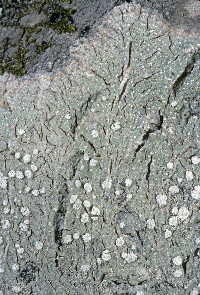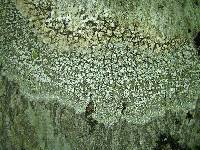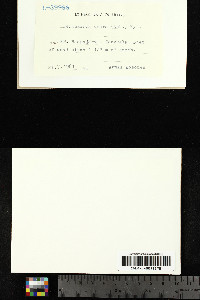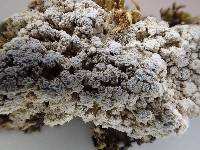
Consortium of Lichen Herbaria
- building a Global Consortium of Bryophytes and Lichens as keystones of cryptobiotic communities -
- Home
- Search
- Images
- Species Checklists
- US States: O-Z >
- US National Parks
- Central America
- South America
- US National Parks
- Southern Subpolar Region
|
|
|
|
Family: Ochrolechiaceae
Bitter Wart Lichen
[Lichen fagineus L., morePertusaria amara (Ach.) Nyl., Pertusaria amara f. amara (Ach.) Nyl., Pertusaria amara f. isidiata Harm., Pertusaria amara subsp. amara (Ach.) Nyl., Pertusaria amara var. amara (Ach.) Nyl., Pertusaria amara var. flotowiana (Flörke) Erichsen, Pertusaria amara var. isidiata (Harm.) Erichsen, Variolaria amara Ach.] |
Nash, T.H., Ryan, B.D., Gries, C., Bungartz, F., (eds.) 2002. Lichen Flora of the Greater Sonoran Desert Region. Vol 1. Thallus: continuous to fissured, with thin to moderately thick verrucae; margin: definite, often zonate upper surface: whitish gray to greenish gray, margins entire to weakly zoned, epruinose soredia: farinose, restricted to verrucae or coalescing and spreading onto ruptured thallus surface Apothecia: no fertile specimens seen Pycnidia: not seen Spot tests: K- or K+ yellow to red, C-, KC+ rose-violet, P- or + yellow to red, UV- Secondary metabolites: picrolichenic and ± protocetraric acids (both major); ± conprotocetraric and subpicrolichenic acid (both minor). Substrate and ecology: on deciduous trees, such as Aesculus, Quercus or conifers, and also occasionally on siliceous rocks in shady places World distribution: widely distributed in the Northern Hemisphere Sonoran distribution: in coastal areas of southern California and Baja California and scattered in inland mountains up to 1800 m in Arizona and Chihuahua. Notes: Pertusaria amara is characterized by small, but coalescing soralia with farinose soredia, a relatively thin, grayish thallus and the presence of the picrolichenic acid chemosyndrome and thus a bitter taste. It is hardly confused with any other Pertusaria species occurring in western North America, except P. albescens. The distinction of both species is discussed above. |
|
|
|
Powered by Symbiota


































































































